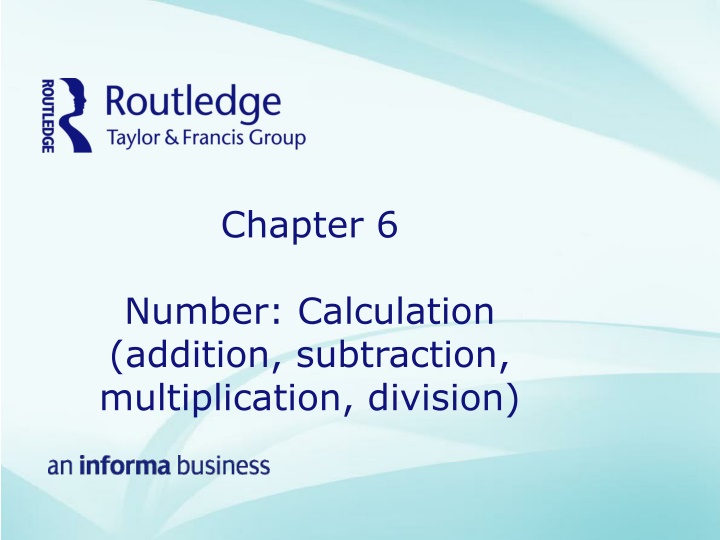
Effective Strategies for Teaching Number Calculations in Primary Mathematics
Enhance primary math education with a focus on mental calculation strategies, practical activities, and the progression of children's math skills. Emphasize problem-solving and avoid misconceptions that hinder learning.
Download Presentation

Please find below an Image/Link to download the presentation.
The content on the website is provided AS IS for your information and personal use only. It may not be sold, licensed, or shared on other websites without obtaining consent from the author. If you encounter any issues during the download, it is possible that the publisher has removed the file from their server.
You are allowed to download the files provided on this website for personal or commercial use, subject to the condition that they are used lawfully. All files are the property of their respective owners.
The content on the website is provided AS IS for your information and personal use only. It may not be sold, licensed, or shared on other websites without obtaining consent from the author.
E N D
Presentation Transcript
Chapter 6 Number: Calculation (addition, subtraction, multiplication, division)
Chapter Summary The chapter makes the link between mental calculation strategies and more formal written methods It suggests that mental methods should always be a first resort It emphasises the importance of children approaching calculation practically and through activity.
Starting point Carry out the following calculations mentally 28 + 37 = 89 + 16 = 48 15 = 107 99 = 26 x 5 = 44 x 4 = Talk to a partner. Discuss the strategies that you used
Good practice in primary mathematics Children should focus on practical activities and developing mental methods in the early stages of their time in primary school. A good understanding of place value and the ability to recall multiplication tables and number bonds supports effective calculation. Your learners confidence and fluency in calculating will be improved if you place a string emphasis on problem solving and make the most of cross curricular links A focus on misconceptions will make sure these do not develop and impede next steps in learning (Ofsted: Good practice in primary mathematics: Evidence from 20 successful schools)
Multiplication and division as arrays This array shows 8 x 4 = 32 4 x 8 = 32 32 8 = 4 32 4 = 8 What number facts can you show with arrays consisting of 24 dots? What about 36 dots?
The progression of childrens development of mental methods Adding and subtracting pairs of single digit numbers Adding single digit numbers to multiples of 10 Adding and subtracting groups of numbers Adding and subtracting 3 digit numbers from multiples of 10s and 100s Multiplying 3 single digit numbers Using place value, known and derived facts to multiply and divide mentally.
Portfolio task Use mental methods to carry out the following calculations. 36 x 9 = 52 x 6 = 84 x 3 Derive at least five new facts from each calculation.
Observing the teaching of calculation Watch the video How many peas fill the classroom? on the companion website. Imagine that you are giving the teacher feedback. What are three strengths that you saw in the teacher s practice? What is an area you would like them to develop? How would you adapt this activity for use in youyr classroom?














